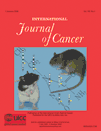Elevation of thyroid cancer risk among cutaneous melanoma survivors
Abstract
Recent molecular studies have identified recurrent BRAF mutations in both cutaneous melanoma and thyroid malignancies. This relatively selective shared genetic vulnerability raises the possibility that these 2 tumors are connected through a common undisclosed pathogenic mechanism. To assess for possible associations between these 2 genetically related tumors at the population level, we calculated standardized incidence ratios (SIRs) for thyroid cancer (TC) among cutaneous melanoma (CM) survivors and CM among TC survivors using the National Cancer Institute's Surveillance, Epidemiology and End Result (SEER) database. Between 1973 and 2000, there were 73,274 and 27,138 cases of CM and TC cases, respectively. Overall, we found a 2.17-fold increase (p < 0.0000001) in the risk of TC after a diagnosis of CM. This augmented risk of TC is somewhat higher for males, for those diagnosed more recently and for the first 3 years after the CM diagnosis. We also detected a considerably smaller and borderline significant increased risk of CM (25%, p = 0.063) among the post-TC survivors. Of note, TC patients who received radiation therapy had a 57% increased risk of a subsequent CM (p = 0.034). Our study documents a strong unilateral risk of TC after CM. More studies are clearly needed to better delineate this mechanism. © 2005 Wiley-Liss, Inc.




